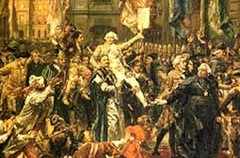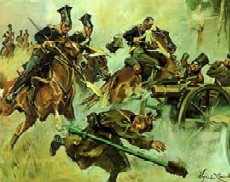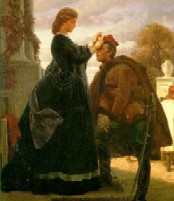Part 4
THE MAY 3rd CONSTITUTION – 1791

By 1770’s, the Enlightenment movement that was sweeping Europe began to take root in Poland. The new king, Stanislaw August Poniatowski (a former favorite of Catherine the Great of Russia), began to cautiously implement reforms. At the same time, the Polish Enlightenment assumed a nationalistic tone. With the first Partition in 1772, which served as a wake-up call, allowed the reformist party in the Kingdom to pass legislation that would aid the state. The reformers’ achievements included establishment of a Commission of National Education and a large, modern army. Their crowning achievement was adoption of the Constitution on May 3, 1791.
The so called May 3rd Constitution wasthe second written constitution in Europe. It guaranteed total political equality to the town dwellers and placed the peasants under state-protection. It sought to create a modern legislative system in Poland by abolishing the liberum veto – the device that had armed the nobility with almost unlimited powers. By effecting a rapid transition from an unworkable feudal anarchy to a modern constitutional monarchy, the Constitution was designed to abolish the abuses of power that had plagued Poland for centuries. All aristocratic titles were abolished and the Sejm granted the hereditary title of Duke to several families only as a recognition of their services to the country.
The Constitution provoked Catherine the Great who feared threat to her hegemony over Poland. In response, she ordered her armies to smash the newly formed government and then supported creation of the Confederation of Targowica, a group of aristocrats who wanted to keep power in their own hands and were, therefore, opposed to the reforms. While the Poles had hoped to form an alliance against Russia with Frederick the Great’s successor, the Prussians chose instead to grab more Polish territory. Against overwhelming odds, the new Polish army resisted the Russian advance but the king lost his nerve and reluctantly joined Targowica. The immediate result was the Second Partition of Poland (1793). The Austrians did not participate directly in the Partition but enough damage was inflicted on Poland to reduce it to a rump-state between Prussia and Russia. Once again, the Polish Sejm bowed to the pressure and rubber-stamped the arrangement.
In the trying times that followed, The Third of May Constitution served as a beacon of hope to the Polish people.
KOSCIUSZKO INSURRECTION – 1794

The Kosciuszko Uprising was Poland’s final attempt to maintain independence. Tadeusz Kosciuszko, a Polish hero of the American Revolution, returned to Poland with hopes of spurring his countrymen to action. Kosciuszko appreciated the winds of nationalism that were blowing across Europe and understood that an independence movement must include the town dwellers and peasants, so long exploited by the nobility. Promising complete equality for the urban population, special protection for the villagers and the eventual abolition of serfdom, he attracted the enthusiastic support of many non-nobles. The Battle of Raclawice is renowned in Polish history for the charge of the Polish peasants. Wielding sharpened scythes, they routed the Russians turning the tide of batlle. Through this valiant effort, after years of suffering, they were finally recognized as a legitimate part of the nation. The combined forces of Russia and Prussia, were, however, too strong for this rag-tag army. Fighting against overwhelming odds, Kosciuszko was wounded at the Battle of Maciejowice and taken prisoner. The failed uprising was followed by the Third Partition of Poland in 1795. Prussia was awarded an enormous amount of territory including Warsaw. The Austrian Empire received the section of south-central Poland contiguous to Galicia including Krakow and Russia took the remaining eastern section of the country. Thus, the Polish state, as an entity, disappeared off the map of Europe. It would take 123 years, until November 11, 1918, before Poland fully regained its independence. Though dreams of independence died, Poland’s populace had been liberated from the bonds of serfdom. Poles outside the nobility were now considered part of the national fabric and the concept of Polish nationalism became an enduring 19th century concept; ensuring the nation’s survival and eventual rebirth.
GRAND DUCHY OF WARSAW 1807 – NAPOLEONIC WARS
Napoleon Bonaparte’s meteoric rise in European politics caught the attention of Poles who saw it as a chance for regaining independence. The Polish Legion under General Dabrowski fought with Napoleon in his earliest campaigns. The charge of Polish cavalry played pivotal role in the victorious battle of Somosierra during Napoleon’s Spanish campaign. It was during this exciting time that the words of the future Polish national anthem, the 'Mazurek Dabrowskiego’ (Dabrowski Mazurka), were written. Originally a marching song, the anthem includes the line „Bonaparte has given us an example how to fight and win.” Napoleon failed to appreciate the extent of the sacrifices made by the

Poles on his behalf. After the defeat of Prussia in 1807, he created a small Grand Duchy of Warsaw from the areas around Poznan and Warsaw, formerly under Prussian partition. In 1809, when the Austrians, in their ongoing war with Napoleon, attacked the Grand Duchy, the tenacious Polish defense at the Battle of Raszyn convinced them to allow the tiny Polish army south-east passage, in exchange for the surrender of Warsaw. This brilliant maneuver allowed Polish army to overrun Austrian-occupied Poland while the Austrian army was tied up garrisoning Warsaw. After Napoleon won his campaign against the Austrians, the north-western part of the Austrian partition was incorporated into the Grand Duchy. This attempt to revive the Polish state, however, was ultimately doomed with the defeat of Bonaparte.
NOVEMBER UPRISING – 1830
In 1815, diplomats from all over Europe gathered in Vienna at a famous Congress to decide what to do with the ruins of Napoleon’s Empire. „The Polish Question” dominated discussions at the Congress. The Tsar wanted all of the historic Kingdom of Poland to be brought under his rule, but this was unacceptable to Prussia, Austria, and especially Britain. The final compromise established the divisions of partition which were to last (with some minor changes) until the regaining of Polish independence. The area around Poznan was returned to Prussia. The rest of the former Grand Duchy of Warsaw, called „the Congress Kingdom” or „the Kingdom of Poland”, was given to the Russian Tsar. Austria retained the lands which it had seized in the First Partition, while Krakow was made into a „free city”.

In the beginning, the Congress Kingdom enjoyed limited autonomy under tsar Alexander I rule. It was granted a constitution, which allowed for separate army and self-government. For a while, there was hope that the tsar would allow some form of association with the Congress Kingdom of the Polish lands beyond the Bug (the river which marked Poland’s eastern frontier). This hope died, however, when Tsar Nicholas I, the „gendarme of Europe,” acceeded the throne. Russian rule became increasingly heavy-handed and on November 29, 1830, an uprising erupted, sparked by the Polish cadets. The uprising engulfed the Congress Kingdom and its finely trained army came over, almost in its entirety, to the rebels. In spite of a promising start, however, delaying the abolition of serfdom and serious mishandling of the military operations bungled the opportunity. The victorious Russians then began a campaign of bloody retribution, launching a period of vicious Russification that devastated Polish life in the Russian part of Poland.
JANUARY UPRISING – 1863

In the aftermath of the November Uprising, Polish insurrectionists, which included among its members some of the most illustrious Poles, emigrated by the thousand to escape tsarist repression. As Poland groaned under the weight of Partitions, the construction of a new kind of Polish nationalism got underway. Leading exponents of this tendency were politician prince Adam Czartoryski, composer Frederick Chopin, the great Romantic poets Adam Mickiewicz and Juliusz Slowacki, and Cyprian K. Norwid.
In 1846, this nationalism sparked a general uprising. Patriots seized control of the „Free City of Krakow” and advanced southward into the countryside. To their horror, the local Polish peasantry turned against them. To those who still clung to the ideals of the aristocracy, the massacre of the patriots sounded a clarion call that the old order was dead. After the uprising, Krakow was incorporated into the Austrian Partition of Galicia.
Polish participation in the Revolutions of 1848 was muted, as it followed too closely in the wake of the ill-fated 1846 uprising. The Hungarian Uprising, in which Jozef Bem served as a general, was brutally crushed when Tsar Nicholas I sent 200,000 troops into Hungary to support the Austrian Empire.
The January Uprising of 1863, launched against the Tsarist Imperial Russia was probably the most desperate. It began as a spontaneous protest of young Poles against the draft to tsarist army. As there was no regular Polish army of any sort, the group of hot headed young people was soon joined by various politicians and high ranking Polish officers from the tsarist army. The insurrectionists were forced to resort to guerrilla warfare tactics and clandestine structures. Throughout the campaign, not one major fortress city in Russian-occupied Poland was captured and, while the occupying armies numbering in the hundreds of thousands were harried, they were never driven out of the country. The uprising did, however, succeed in blunting the effect of the Tsar’s abolition of serfdom in the Russian partition, which had been designed to win Polish peasants away from supporting the rest of the Polish nation. Severe reprisals against the Poles, such as public executions or deportations to Siberia, led many Poles to abandon armed struggle and turn instead to the idea of „organic work” – the economic and cultural self-improvement.
After 1867 in the Austrian partition (Galicia), the Poles obtained a wide-ranging autonomy, including the right to conduct their government and run the education system in Polish language. This was part of the general transformation of the Austrian Empire into the Austro-Hungarian Empire, where Hungary finally received virtual independence. Many Polish intellectuals and artists left France and settled in Galicia. The role of cultural capital of Poland was passed back to Krakow. Until 1918 it was the only place in partitioned Poland where Polish cultural life flourished in all its aspects.
In contrast to Austro-Hungarian Empire, Russia and Prussia (soon to become the leading region of a unified Germany) banned the use of Polish in public affairs and everywhere in the education system – the teaching of Polish language, literature, and history had to be carried out on a virtually clandestine basis. The administration of the country in both areas, on practically every level, was almost completely in the hands of non-Poles.
Wielu graczy zastanawia się, jakie są najpopularniejsze automaty jednoręki bandyta w 2023 roku. W wizyta w popularnym legalnym kasynie online i odwiedziny w dziale z najchętniej wybieranymi grami pomaga rozeznać się w obowiązujących trendach. Można zaobserwować dwa takie trendy. Pierwsza kategoria najpopularniejszych automatów na pieniądze to najlepsze klasyczne gry na pieniądze: owocówki, gaminatory, gry 777. Tego typu proste automaty w klimacie retro od zawsze przyciągały fanów hazardu, gdyż nawiązują do atmosfery sprzed kilku dekad. Można przy nich miło spędzić czas, a wiele z nich oferuje przy okazji całkiem wysokie jackpoty. Druga kategoria gier na pieniądze, która cieszy się popularnością, to nowoczesne automaty od takich dostawców jak Pragmatic Play czy Play’n GO. Za przykład może tutaj nam posłużyć automat na pieniądze Money Train 2. To jedna z bardziej zaawansowanych gier hazardowych dostępnych na rynku. Posiada ona wiele dodatkowych rund specjalnych, mnożniki, ponad 10 specjalnych symboli i powiększające się bębny.